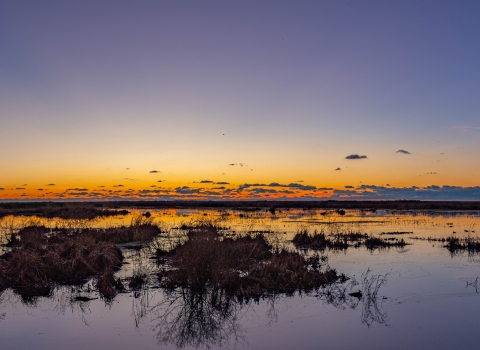The U.S. Fish and Wildlife Service has submitted to Congress its Report to Congress: John H. Chafee Coastal Barrier Resources System John H. Chafee Coastal Barrier Resources System
Learn more about the John H. Chafee Coastal Barrier Resources System, which was established under the Coastal Barrier Resources Act in 1982.
Learn more about John H. Chafee Coastal Barrier Resources System Hurricane Sandy Remapping Project. The report includes revised maps for 438 Coastal Barrier Resources System (CBRS) units in the nine states most affected by Hurricane Sandy: New Hampshire, Massachusetts, Rhode Island, Connecticut, New York (Long Island), New Jersey, Delaware, Maryland and Virginia. Hurricane Sandy made landfall along the northeast coast of the United States in 2012 and was one of the most destructive and costliest storms in U.S. history.
Comprehensively revising the maps through this project will help enhance coastal resiliency and sustainability by improving compliance with the program, adding vulnerable coastal areas to the CBRS, while providing more accurate and accessible data for planning coastal infrastructure projects, habitat conservation and flood risk mitigation measures. This effort also corrects mapping errors affecting property owners.
Coastal barriers, the low-lying dynamic landforms and associated wetlands along the coast, serve as natural storm buffers for coastal communities and ecosystems, moderating destructive waves and absorbing floodwaters. Development of these areas can put people in harm’s way and disrupt the natural movement and functions of the barriers while degrading fish and wildlife habitat and increasing shoreline erosion.
The report and revised maps transmitted to Congress for the Hurricane Sandy Remapping Project recommend the removal of 1,361 acres (mainly uplands) that were erroneously included within the CBRS in the past. The report and revised maps also recommend the addition of 277,950 acres to the CBRS (mainly wetlands and open water) that meet the criteria for an undeveloped coastal barrier. The revised maps would remove 910 structures (mostly private residential) from the CBRS and add 274 structures to the CBRS (more than half of which are park-related). The public was provided an opportunity to comment on the proposed changes through comment periods held in 2018 and 2019.
The recommended changes will only take effect once the revised maps are adopted by Congress through legislation. Development still can occur in areas added to the CBRS provided that private or other non-federal parties bear the full cost of building or re-building in these highly vulnerable, biologically important areas.
The geographic units of the CBRS are depicted on a set of maps that is maintained by the Service. With minor exceptions, only Congress has the authority to modify the boundaries of the CBRS by adopting new maps through legislation.
The CBRS maps were last comprehensively updated decades ago using now-outdated cartographic techniques and some of the maps contain errors that impact property owners, developers, and local communities. Congress recognized the deficiencies associated with the outdated maps and, through the 2006 reauthorization of the Coastal Barrier Resources Act (CBRA), directed the Secretary of the Interior to modernize the maps and recommend additions to the CBRS.
Congress recognized the value of coastal barriers coastal barriers
Learn more about coastal barrier landforms.
Learn more about coastal barriers when it enacted CBRA in 1982 and established the CBRS. CBRA continues to save federal taxpayer dollars and reduce the intensity of development within hurricane-prone and ecologically sensitive coastal areas. Most new federal expenditures and financial assistance are prohibited within the CBRS, including federal subsidies associated with infrastructure projects, disaster assistance, and flood insurance.
A 2019 study published in the Journal of Coastal Research found that CBRA has saved Americans $9.5 billion between 1989 and 2013 and forecasts that additional savings will range between $11 and $109 billion during the next 50 years. Furthermore, a study published through PLOS ONE in 2020 evaluated the effectiveness of CBRA in discouraging urban development on coastal barriers, and found that it has been successful in its intention of decreasing development rates and densities of hazard prone coastal areas.
For more information, please see our factsheet on the CBRS Hurricane Sandy Remapping Project. Additional information is available on the Service’s CBRA website at: https://www.fws.gov/cbra.



